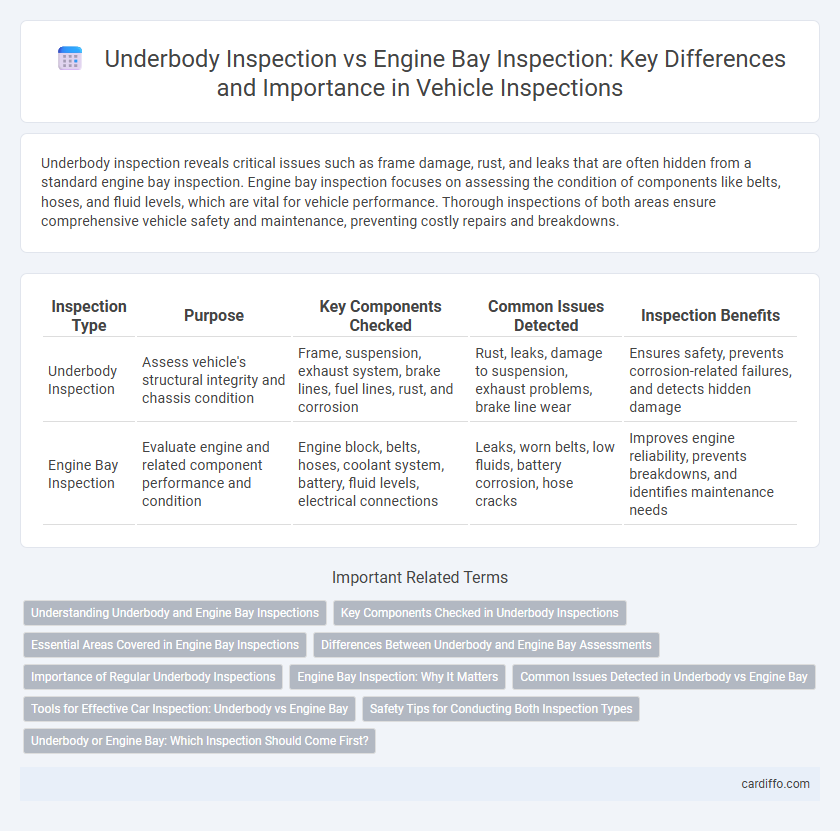Underbody inspection reveals critical issues such as frame damage, rust, and leaks that are often hidden from a standard engine bay inspection. Engine bay inspection focuses on assessing the condition of components like belts, hoses, and fluid levels, which are vital for vehicle performance. Thorough inspections of both areas ensure comprehensive vehicle safety and maintenance, preventing costly repairs and breakdowns.
Table of Comparison
| Inspection Type | Purpose | Key Components Checked | Common Issues Detected | Inspection Benefits |
|---|---|---|---|---|
| Underbody Inspection | Assess vehicle's structural integrity and chassis condition | Frame, suspension, exhaust system, brake lines, fuel lines, rust, and corrosion | Rust, leaks, damage to suspension, exhaust problems, brake line wear | Ensures safety, prevents corrosion-related failures, and detects hidden damage |
| Engine Bay Inspection | Evaluate engine and related component performance and condition | Engine block, belts, hoses, coolant system, battery, fluid levels, electrical connections | Leaks, worn belts, low fluids, battery corrosion, hose cracks | Improves engine reliability, prevents breakdowns, and identifies maintenance needs |
Understanding Underbody and Engine Bay Inspections
Underbody inspection focuses on identifying rust, corrosion, leaks, and damage to components such as the exhaust system, suspension, and brake lines beneath the vehicle. Engine bay inspection targets the condition of the engine, coolant levels, belts, hoses, and electrical connections for performance and safety evaluation. Both inspections are critical for comprehensive vehicle maintenance, ensuring structural integrity and engine reliability.
Key Components Checked in Underbody Inspections
Underbody inspections primarily focus on key components such as the exhaust system, suspension, brake lines, and fuel tank to identify signs of corrosion, leaks, or structural damage. Inspectors evaluate the condition of the chassis, steering linkage, and protective shields to ensure vehicle safety and performance. These checks are essential for detecting issues that are not visible during engine bay inspections, which mainly target engine parts and fluid levels.
Essential Areas Covered in Engine Bay Inspections
Engine bay inspections primarily focus on essential areas such as the battery, belts, hoses, fluid levels, and wiring connections to ensure optimal vehicle performance and safety. This detailed examination identifies potential issues like leaks, corrosion, wear, or electrical faults that could lead to engine failure or reduced efficiency. Regular engine bay inspections contribute to early detection of problems, supporting timely maintenance and extending the lifespan of critical engine components.
Differences Between Underbody and Engine Bay Assessments
Underbody inspection focuses on the vehicle's chassis, suspension, exhaust system, and structural integrity, identifying rust, damage, or leaks that affect safety and performance. Engine bay inspection concentrates on the engine components, fluid levels, belts, and electrical connections critical to engine functionality and maintenance. Both assessments target different vehicle areas, emphasizing unique elements crucial for comprehensive vehicle evaluation.
Importance of Regular Underbody Inspections
Regular underbody inspections are crucial for identifying rust, structural damage, and fluid leaks that are often hidden from view, ensuring vehicle safety and longevity. Unlike engine bay inspections, which focus primarily on engine performance and components, underbody checks detect issues related to the chassis, suspension, and exhaust systems that directly affect roadworthiness. Timely detection of underbody problems prevents costly repairs and maintains optimal vehicle integrity.
Engine Bay Inspection: Why It Matters
Engine bay inspection provides critical insights into the vehicle's performance and safety by identifying leaks, corrosion, worn belts, and electrical issues that are not visible during underbody inspection. This detailed examination helps prevent engine overheating, power loss, and costly repairs by ensuring components like the radiator, battery, and hoses are functioning correctly. Prioritizing engine bay inspection enhances vehicle reliability and extends engine lifespan through early detection of potential problems.
Common Issues Detected in Underbody vs Engine Bay
Underbody inspections commonly detect issues such as rust, corrosion, exhaust system damage, and suspension wear, which can compromise vehicle safety and performance. Engine bay inspections reveal problems like fluid leaks, worn belts, faulty wiring, and overheating symptoms that directly impact engine efficiency. Both inspections are crucial for comprehensive vehicle maintenance, but they target distinct components prone to specific types of damage.
Tools for Effective Car Inspection: Underbody vs Engine Bay
Specialized tools for underbody inspection include hydraulic lifts, creepers, and LED undercarriage lights, enabling thorough examination of the vehicle's frame, suspension, and exhaust system. Engine bay inspection relies on diagnostic scanners, battery testers, and infrared thermometers to assess engine performance, electrical components, and heat distribution. Using the appropriate tools for each inspection area ensures accurate diagnostics and effective maintenance planning.
Safety Tips for Conducting Both Inspection Types
Prioritize wearing protective gloves and eye protection during underbody and engine bay inspections to prevent injuries from sharp edges and hazardous fluids. Ensure the vehicle is securely lifted and stabilized using appropriate jack stands before performing underbody inspections to avoid accidental falls or vehicle shifts. Always disconnect the battery and allow the engine to cool down prior to inspecting the engine bay to reduce the risk of electrical shocks and burns.
Underbody or Engine Bay: Which Inspection Should Come First?
Underbody inspection should come first because it reveals critical issues such as frame damage, exhaust system leaks, and suspension problems that affect vehicle safety and performance. Inspecting the engine bay second allows for a detailed assessment of engine components, fluid levels, and electrical connections once the vehicle's structural integrity is confirmed. Prioritizing underbody inspection ensures a comprehensive evaluation and prevents overlooking foundational vehicle issues before examining the engine bay.
Underbody inspection vs engine bay inspection Infographic

 cardiffo.com
cardiffo.com